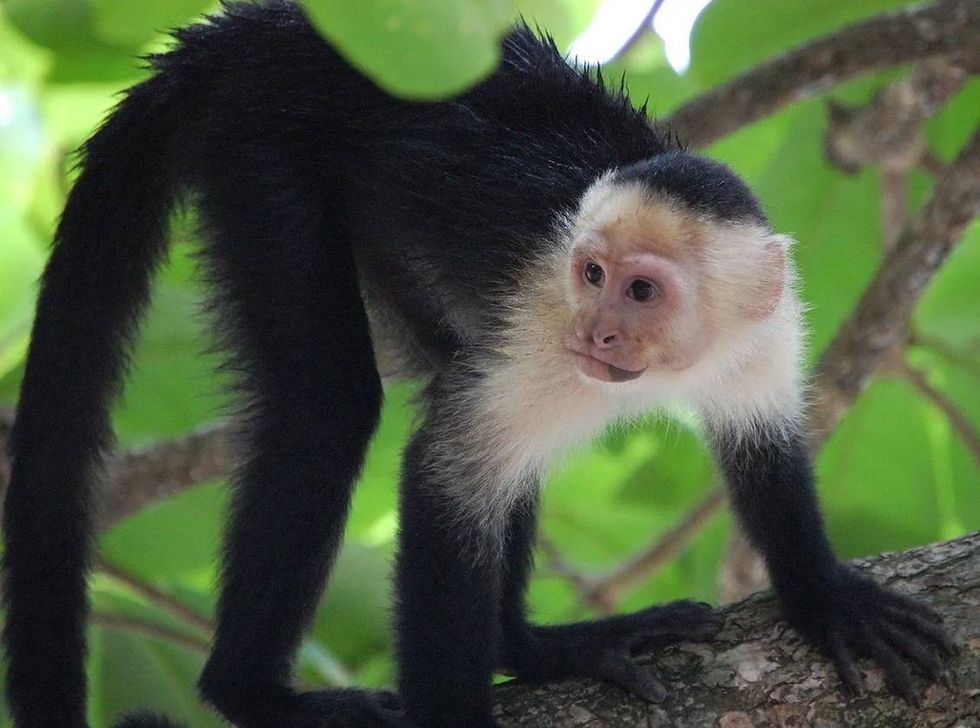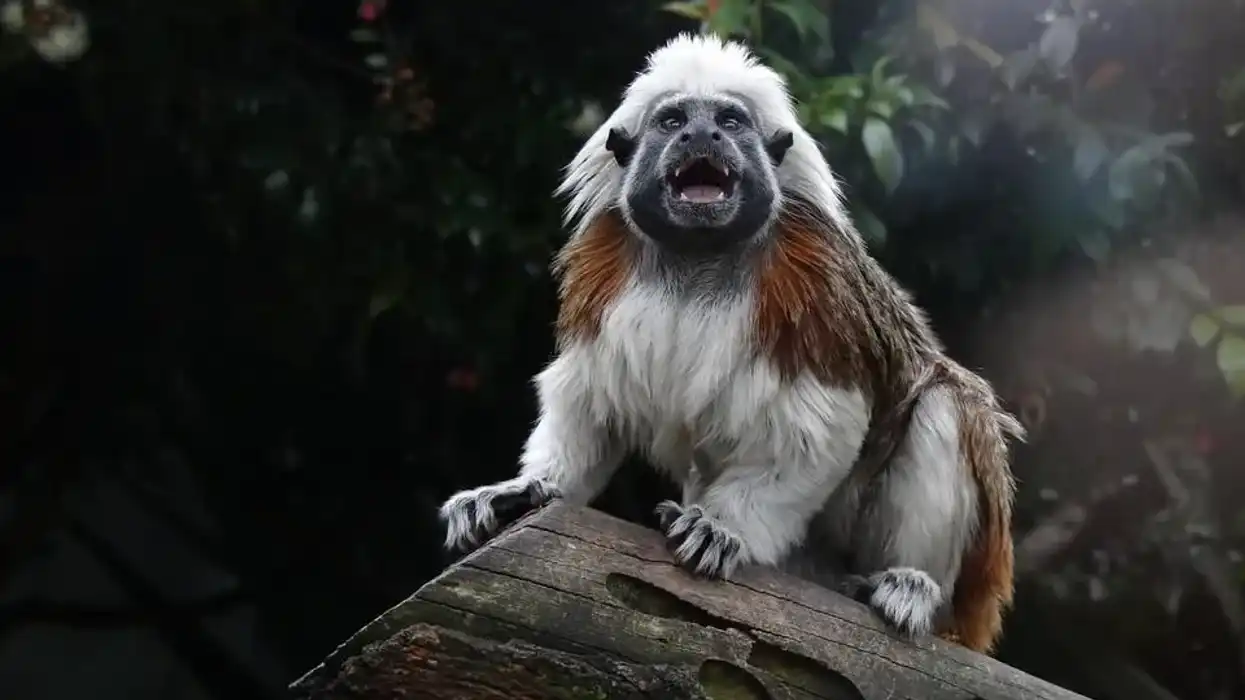Have you ever seen a medium-sized Panamanian white-faced capuchin monkey? It is one of the famous New World monkeys with the scientific name Cebus imitator, often shown on tv shows including 'Friends' and the 'Pirates of the Caribbean film series; they are also easily identified as organ grinder monkeys.
We will tell you all about these beautiful mammals here. They are found in tropical forests of South America and Central America's Caribbean coasts of Costa Rica and throughout Panama.
They are also commonly known as Panamanian white-faced capuchin monkeys and Central American white-faced capuchin monkeys. Their closest cousin, the Colombian white-faced capuchin (Cebus capucinus) from the same genus, is considered the same species by some primatologists.
An interesting feature about these species is that they almost have an extra hand; we mean their long and strong tail that is also nicknamed ringtails. They use their tail to hang on branches and tree limbs as they move through the treetops.
These monkeys live high in the canopies of trees where they can hide from predators, find food, and communicate with others in their group.
If you enjoy learning about this Capuchin monkey, then check out woolly monkeys and patas monkeys too.
White-Faced Capuchin Interesting Facts
What type of animal is a White-Faced Capuchin?
The Panamanian white-faced capuchin (Cebus imitator) is a monkey from the family Cebidae. There are five to six types of capuchin monkeys, such as wedge-capped capuchin, black-capped capuchin, and Kaapori capuchin, among others. The Colombian white-faced capuchin (Cebus capucinus) is also considered the same species.
What class of animal does a White-Faced Capuchin belong to?
White-faced capuchins belong to the class Mammalia and genus Cebus.
How many White-Faced Capuchins are there in the world?
In 1995, there were 95,000 capuchins, and in 2007, only 54,000 of them are left. Their populations are expected to have declined by 43% in the last 12 years.
Where does a White-Faced Capuchin live?
These capuchins are found in Central America in Costa Rica, Nicaragua, Honduras, and Panama. They also live in a small part of the extreme north-western South America, mainly in Ecuador and Colombia.
It has been seen in southern Belize and eastern Guatemala, but this information is from unconfirmed reports. In Central America, these monkeys are most commonly seen in national parks such as Santa Rosa National Park, Manuel Antonio National Park, Soberania National Park, and Corcovado National Park.
What is a White-Faced Capuchin's habitat?
These monkeys are found in various forest environments, including deciduous and evergreen forests, montane and mangrove forests, and moist and dry forests. Capuchins prefer hanging around treetops and canopies.
Who do White-Faced Capuchins live with?
These highly social monkeys form groups of 18-20; these groups go by many names such as cartload, a barrel, a troop, and a tribe. Now you know if you ever spot a barrel of monkeys, they are not just there for playing.
Most of these troops consist of females, and females stick with one group throughout their lives.
Males hop between troops as they grow. These animals need high humidity levels to survive; when you see these monkeys sticking their tongue out, they are not acting rude; they try to allow moisture to evaporate to stay cool in the dry season.
How long does a White-Faced Capuchin live?
White-faced capuchins, both Panamanian (Cebus imitator) and Colombian (Cebus capucinus), can live up to 45-50 years if kept in a wildlife preserve or a zoo. The average lifespan of these animals in the wild is around 30 years. The oldest known White-faced capuchin reached 54 years of age.
How do they reproduce?
With multiple male and female partners, the White-faced capuchin is categorized as polygamous. As per the dominance hierarchy, alpha males have more mating opportunities.
The peak breeding season is between January to April, although adult females reach sexual maturity at around four years but do not give birth until seven years. Males become sexually active between 7-10 years old. A pregnant female capuchin's gestation period lasts for 160 days, and it gives birth to one baby at the end of this period.
What is their conservation status?
Panamanian white-faced capuchins are classified as Least Concern with the population decreasing. Although this decline is not very steep, efforts are underway to increase their population in various organizations, zoos, and wildlife conservation groups. Their decline is attributed to deforestation hunting by humans to sell them as exotic pets.
White-Faced Capuchin Fun Facts
What do White-Faced Capuchins look like?
With pinkish-white-cream color faces, these good-looking primates have black fur throughout their bodies except yellow/white fur on the upper chest, neck, arms, and shoulders. Sometimes, these white-throated capuchin monkeys can have dark fur patches on the face and black fur on the head like a black cap.
They have strong prehensile tail that helps them hang and balance on tree branches.
How cute are they?
Panamanian white-headed capuchins have charming antics and cute faces. These looks are why they are also very famous on television with all sorts of performances.
These funny behaviors are frequently observed in captivity, but they also occur in the forest. Especially the young members of the troop spend their time wrestling, playing, and relying on social learning by observing adults, which is fascinating to watch.
How do they communicate?
Commonly seen throughout Costa Rica, these White-faced capuchins are some of the most intelligent primates. They use various sounds to communicate, alert about potential predators, and more. They use coughs, barks, whistles, and chirps to stay safe; these sounds allow them enough notice to escape the area and go higher up in the trees.
How big is a White-Faced Capuchin?
New world White-faced capuchins are generally larger than Mantled Howlers. Their body is around 13.2-17.8 in (335-453 mm) with a tail longer than the body with 21.7 in (551 mm) in length. Males are 27% larger than females; males are also more vigilant than female capuchins.
How fast can a White-Faced Capuchin move?
White-faced capuchins are fast-paced when they move between trees and branches in their habitat. White-headed monkeys recorded speed is about 34 mph (54.7 kph).
How much does a White-Faced Capuchin weigh?
The males can weigh up to 8 lb while females weigh slightly less when compared to males, around 5 lb. An eight-pound male is the same weight as a gallon of milk.
What are the male and female names of the species?
There are no specific names for males and females Capuchin species. White-faced capuchins are generally referred to as male and female capuchins.
What would you call a baby White-Faced Capuchin?
A white-headed capuchin baby is called an infant. An infant is capable of seeing since birth and is taken care of by its mother for up to four months. As it reaches four-five months, it becomes independent and looks for food such as nuts, insects, and fruit.
What do they eat?
The White-headed-capuchin is a diurnal species, it finds food during the daytime using different tools and sleeps at night. As they are omnivores, they eat both plants and meat.
They eat insects, small birds, lizards, and tree rats in addition to fruits and nuts. They are always willing to try a new variety of foods, even unfamiliar fruits or insects, so it's easy for them to find food in their habitat.
Are they aggressive?
Although Capuchins' first defense is to run away, there have been times when the troop members come together to fight the intruding predator. These primates are wild animals, and they can be dangerous by lashing out their claws and teeth to fight when they are threatened.
Females can be especially aggressive when they feel their infants are in danger; the male capuchins fight with other males to protect their territory from females in the troop.
Would they make a good pet?
White-headed capuchin species are commonly kept as pets and are also hunted for food. Although this is a small-sized monkey, it could be very unpredictable, so they are not suitable as pets.
Chances are, these monkeys may attack people who take care of them as they can become frightened quickly. These animals are also vulnerable to intestinal parasites causing terrible sickness or even death.
Did you know...
Panamanian white-headed capuchin monkeys are considered among the 10 most intelligent primates of the New World monkeys based on a study conducted in 2007; they are subjected to many studies on intelligence and behavior.
They are known to use tools in different ways, from getting food to beating snakes to protect themselves or release an infant. They also rub their bodies against certain plants, the purpose of this could be to deter parasites or get the benefit of the anti-inflammatory agent from these plants.
These animals also play a crucial role in influencing forest regeneration by seed dispersal.
How much does White-Faced Capuchin cost?
If you'd like to purchase a capuchin monkey, it may cost you around $5,000-$7,000. However, caution is advised on finding a reputed breeder only as these babies are hunted in the forest or taken from their mothers at an extremely young age.
Is the White-Faced Capuchin a good pet?
These white-headed primates are undoubtedly cute-looking primates and may be very appealing to watch them perform on a television show, but this should not be confused with having them as a pet. They are wild animals that should be observed in a zoo park or other protected area.
These small monkeys' behavior can be highly unpredictable and can transmit diseases like malaria through their bite.
Here at Kidadl, we have carefully created lots of interesting family-friendly animal facts for everyone to discover! Learn more about some other mammals from our proboscis monkey fun facts, and howler monkeys interesting facts pages.
You can even occupy yourself at home by coloring in one of our free printable white-faced capuchin coloring pages.










